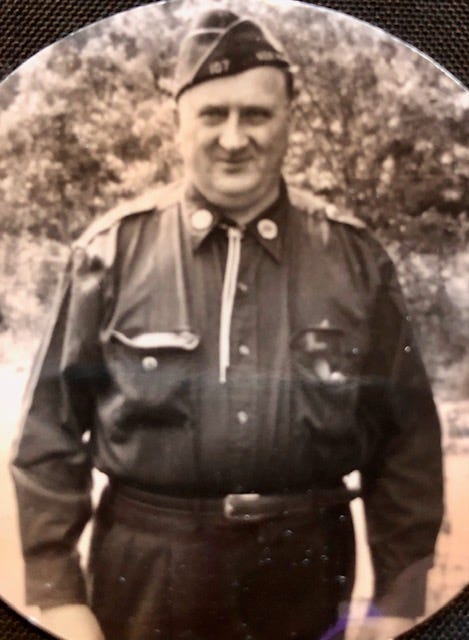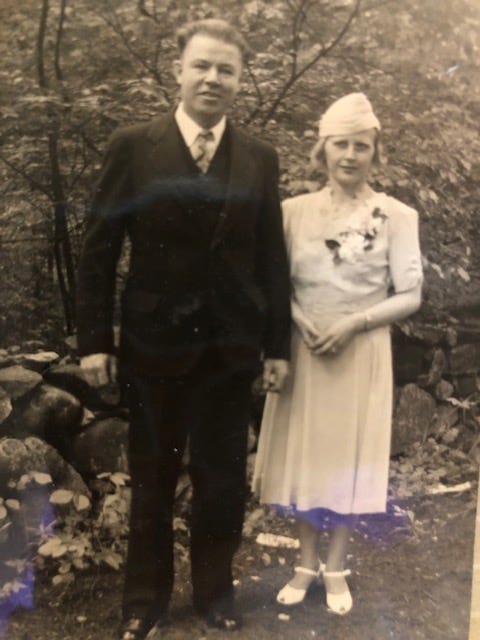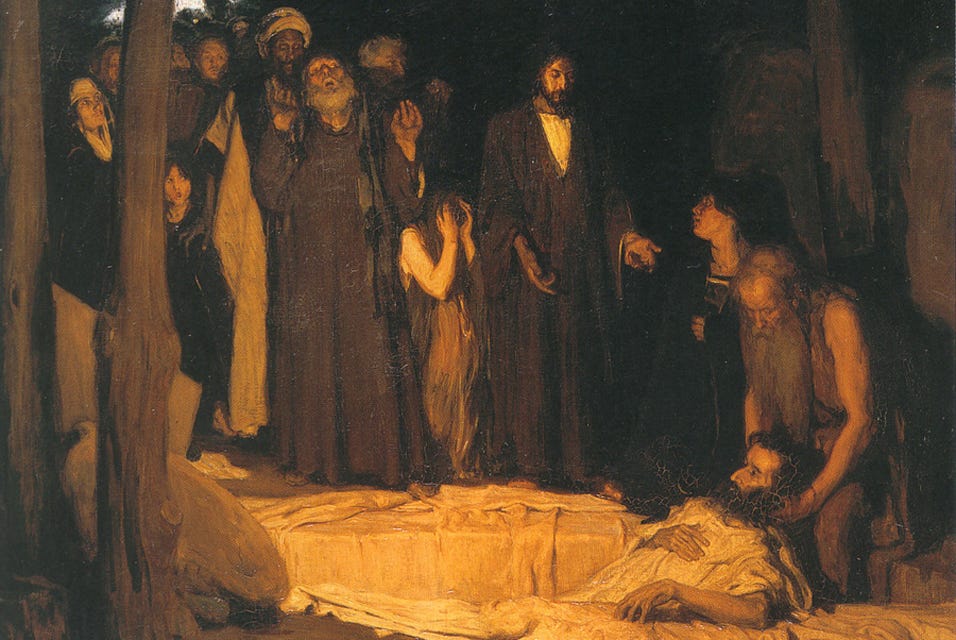Built in 1816-17. First used for the joint purpose of Town Hall and Academy. This was the second building used for the Appleton Academy. Photo was taken October 1907.
WWII Veterans
Hazel Moore compiled a photo album of New Ipswich WWII veterans for the New Ipswich Historical Society. She was not able to obtain a photo for every WWII veteran. Ruby Maki Edwards provided the Society with three more photos.
On this day - May 1, 1908
James Roger diary entry
1st May 1908 (Friday)
Rain during night. Fair day but cold high W. wind threatening frost at night. Temp 34 at 10 pm. David teaming wood for Mr. Walker. Mother and I got hall ready for dance tonight.
On this day - May 1, 1897
William Jurian Kaula diary - SALON du CHAMPS
Perhaps the most interesting canvas and the one that comes nearest to being an artistic success as being the most important picture in the Salon is Gervais' "La folie de Titania."
I have heard that it does not represent the subject very faithfully but I only looked at it as a painting which surely told its own story without regard to historical accuracy. In arrangement and composition it is meant to be decorative yet each part is painted in a realistic manner. The work immediately caught the attention for its beautiful color. The twilight effect that sifts through the trees and falls upon the shoulders of the nude figures is superbly painted and is more or less iridescent with the warm lights and cool shadows that are generally so crudely painted by the majority of artists that attempt to produce such effects. The poses of the various figures which are life size suggest somewhat of the poses that the students usually give to the models in the acadamies for studies. Here is one that is standing in a familiar pose, another is seated as if on a stool waiting patiently for her time to rest, another is reclining, and so on but one of them are paying much attention to the central figure that wears the head of an ass and she is evidently the favored one in this lawn fété. A few Japanese lanterns and some clothing on the young ladies who have made this an excellent afternoon party.
Jean Paul Laurens is represented in this room by a huge landscape entitled "Le Lauraguais."
It is a vast expanse over the bare hilltops which are bare and brown which are being cut in furrows by the ploughmen and the oxen. It is purely decorative in treatment but falls far short of being the mural decoration that was intended. This work will hardly rank with his previous efforts which have made him so famous and I think that it is calculated to do him more harm than good. In spite of the general dissatisfaction that has been expressed over this work it has been purchased by the state.
Sorolla is a Spanish painter who likes to paint the brilliant sunlight effects of his country. The subject of his large canvas was well chosen for an example of how well and how far the use of paint can be employed to produce an effect of realistic sunshine.
There are some women mending a white canvas sail under an arbor, the sail being the most conspicous object and it is a most wonderful piece of painting of light and shadow with all the glow and color of reflected lights, and surrounding the whole is a gorgeous effect of green leaves spotted everywhere with sunlight. It is a great performance with the brush and a fine example of realism and not much more. Sorolla is not a painter who searches for refinement nor delicacy of treatment but for actual facts and for subjects of strong contrast in light and shade, and brilliant color. He is represented in the Luxumberg Gallery by a large painting of oxen drawing a boat in shallow water.
I do not like Henri Martin's huge canvas with the motley throng of wretches that are following a woman who has two umbrella-like wings. Martin is a rabid Impressionist and seems to have all the faults of that school of painting put together. He makes a great attempt at painting large masses in a simple manner yet the whole is executed in a multitude of colored spots like so much confetti flying in the wind. The figures are not well drawn and it would be flattery to say that some even resembled wood. It is his own peculiar method of smear and daub that has made him famous. (Diary footnote: "Vers l'Abîme: a woman with enormous bat-wings, and bare to the waist except for a black cloak streaming behind her, is apparently fleeing from a company of nondescript gentlemen of all ages, who have much difficulty in keeping their feet, and who climb over one another in their mad race. Trite, of course, in a way; but the coloring is the painter's own and several tons of paint are consumed. Red and yellow and derivatives - are the principle tones. Most of the complexions are peeling off and the tint of the flesh vies, in a sickly ruddiness, with that of the sky and ground." from a publication, "A Rank Outsider" in The Quartier Latin, May 1897 )
Bouguereau has his usual sweet and pretty Christmas cards with the pearly and waxen flesh-tones. "The Christ in the Crucifixion" is nothing but a model with beautiful skin. It expressed no more.
Detaille the painter of military life has a small work which was ordered by the State, "Les Funéraille de Pasteur." It may have a great historical value but it is like a colored photograph.
Jules Breton the old peasant painter has changed very much and no longer paints with the dull browns and lifeless color of "the men of 1830." It is astonishing to note the revolution that has come about during the past few years that has forced the painters to get nearer to nature in regard to truth and variety of color. It is being overdone of course by many men and their works are crude and harsh. This is more apparent at the New Salon where the majority of the Impressionists expose their startling pictures.
Collin did not send an important work but his two small canvases were full of his charming and delicate color that gives them so much quality. I only wish that I could study under him during the summer as well as in the winter.
Bonnat paints portraits that have the effect of a flash-light; hard and forced beyond nature with a cavernous background that descends into a coal-mine. The other work consists of an eagle pouncing down upon a rabbit which was dry and uninteresting.
Among the Americans who stand out conspicuously is Tanner who has attracted considerable attention with his "Resurrection of Lazarus."
It has been praised by some of the French critics and he may receive a medal*. (Diary footnote: June 14 - I have just heard that Tanner has been awarded a third class medal, and his picture has been purchased by the State - the latter being one of the greatest distinctions that a young artist can receive in France. If Tanner keeps on it will lead to higher honors. Louis Loeb the illustrator so well known in the century and other magazines at home was awarded a medal for his portrait of Miss Friend of Boston. I have not mentioned the work as I did not think it was good though it showed much merit. Walcott, Mitchell's "friend" received an Honorable Mention for a portrait). The subject is conceived in the imitation of the Old Masters and very simply rendered. As a composition the figure of Christ fails to occupy an important position and it is only to be recognized among the number by the traditional cut of the beard and garments - of the landscape work in the Salon. I might write pages about many works of merit and the host of unsuccessful attempts of the Hors Concour men who still cling to the prehistoric ideas of the beautiful in nature. A landscape of a green field and trees at St. Cloud by Tanzi pleased me very much. It was so far above the average landscape in the Salon and left a decided impression upon the mind in which the others fail.
There was something familiar about W.L. Picknell's landscape which I soon found was painted at Moret along the river. It was plastered thickly with paint and was rendered with his usual characteristic solidity and artificial atmosphere. His eyesight does not seem to have changed since he has painted at Annisquam, Mass...I was once an enthusiastic admirer of F.A. Bridgmann who painted such brilliant Oriental scenes. And E.L. Weeks as well who paints the same life. They both seem rather dry. Frank Du Mond did not complete his picture of the "Holy Family" which I described before (Jan. 3) and sent a small study of the same subject and a full-length portrait of his wife. It is not very good as the high-lights on the face are so bright as to resemble grease. Glover, Logan, and Kronberg do not loom up very well among the hundreds of pictures. Kronberg's is by far the least conspicuous as it is so dead in color and hung so poorly as to be difficult to examine. (Diary footnote: Mitchell and Walcott each sent a canvas of the same subject which they painted together last summer. It was rather odd that both were accepted and the mistake was made by the jury who imagined it was the same work presented for vote twice. The two fellows had quarreled and did not consult each other.)
The display of water-colors and pastels is very disappointing and contains a vast amount of trash. It looks like an easy thing to have a water-color or pastel accepted for the Salon - The sculpture is very good and far outranks the display at the New Salon.
*Tanner is the only colored member of the Am. Club. He received a "Honorable Mention" last year at the Salon.









Town Hall is a building worth preserving. E.L.Thoms's gr-gr-grandfather, Col. Ivers Phillips, 1805-1900, was a student at New Ipswich Academy, perhaps when this building was new. Question: Does the Historical Society have in its possession the Academy's attendance records?